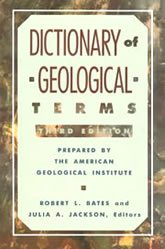Geological Terms Beginning With "I"
For terms beginning with other letters, please click below
|
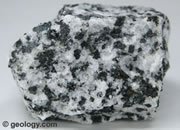
Igneous Rock
A rock formed by the crystallization or solidification of molten rock material. They can form underground, on the surface or as ejecta. The rock in the photo is a piece of diorite.
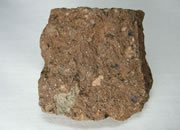
Ignimbrite
The material deposited by a pyroclastic flow. These materials may have been indurated by heat as in the case of a welded tuff, or, they may be indurated by later crystallization as in the case of sillar. The rock in the photo is tuff.
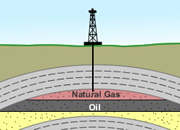
Impermeable Layer
A layer of rock, sediment or soil that does not allow water to pass through. This could be caused by a lack of pore space or pore spaces that are so small that water molecules have difficulty passing through. The illustration shows an anticline serving as an oil and natural gas reservoir. The oil and gas are trapped in a sandstone by an impermeable layer of shale above.

Impervious Surface
A land area that has been covered by pavement, buildings or other land cover that prevents the infiltration of water. In these areas precipitation and snow melt run off rapidly instead of infiltrating into the ground. When the percentage of impervious surfaces in an area becomes high, flash flooding can occur and ground water recharge will be limited. To avoid these problems, developers are often required to include catchment basins and dedicated areas for infiltration in their development plans.
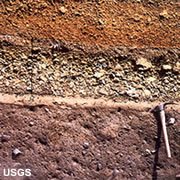
Indurated
The process of solidifying or hardening a material into a rock through pressure, cementation or heat. The photo shows layers of stratified tuff near Mount St. Helens.

Infiltration
The movement of surface water downwards into porous soil. The image shows the infiltration of water into the ground from the channel of a stream.

Influent Stream
A stream, usually flowing in an arid area, that loses water into the ground through the bottom of its channel. This loss occurs because the water table is below the channel of the stream. Influent streams decrease in discharge in a downstream direction and often lose all of their water into the ground.
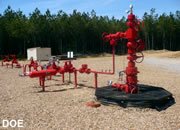
Injection Well
A well that is used to force a liquid or gas into the ground. The injection could be done for waste disposal, for underground storage, for enhanced oil recovery, to fight underground fires, to fill subsurface voids, for geothermal heat recovery or a number of other reasons.
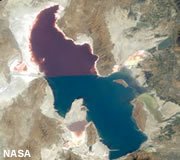
Interior Drainage
A system of streams that flow into a landlocked basin and evaporate or infiltrate, instead of flowing into an ocean. The image shows Great Salt Lake, the world's fourth largest lake fed by interior drainage.
Intermediate Rock
An igneous rock that has an intermediate silica content. Examples are syenite and diorite. Also see entries for acidic, basic and ultrabasic rocks

Intermittent Stream
A stream that goes dry at certain times of the year. Intermittent streams flow during seasons of the year when runoff and/or groundwater contributions sustain the flow of the stream. They stop flowing during dry seasons when precipitation is low and the water table drops below the bed of the stream.
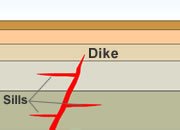
Intrusion
An igneous rock body that formed when magma forced or melted its way into, through or between subsurface rock units. The illustration shows a dike cross-cutting sedimentary rock units and sills injected between bedding planes within those units.

Intrusive
Igneous rocks that crystallize below Earth's surface. They typically have mineral crystals that are large enough to easily see with the unaided eye. The rock in the photo is a piece of diorite about two inches across.
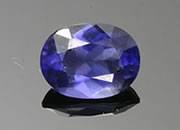
Iolite
Iolite is the name given to gem-quality specimens of the mineral cordierite. It is a strongly pleochroic gem material that, when properly oriented, can produce gemstones with a deep bluish color similar to sapphire and tanzanite.
|
Dictionary of Geological Terms - Only $19.99 All scientific disciplines have an essential vocabulary that students and professionals must understand to learn and communicate effectively. A geology dictionary that is used regularly is one of the most important tools for developing professional competence. A good dictionary should be on the desk of every geologist and within easy reach. This dictionary is compact and inexpensive at only $19.99. More information. |
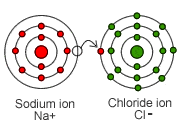
Ion
An atom that has either lost or gained one or more electrons and now carries a positive or negative charge. The charge will be positive if there was a loss of electrons and negative if there was a gain of electrons. In the image a sodium ion has lost one electron and the chlorine has gained one electron.
Ionic Bond
A chemical bond formed by the electrostatic attraction between oppositely charged ions.
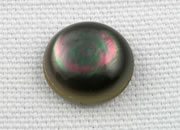
Iridescence
A rainbow-like display of colors in the shallow interior of a material that is produced when light is separated into bands of different wavelength by layers of different refractive index within the material. Mother of pearl is a material widely known for its iridescence.
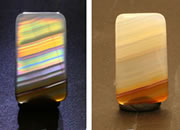
Iris Agate
Iris agate is a finely banded agate with a spectacular display of color when it is cut into thin pieces and illuminated from a direction that sends light through its very thin bands.

Iron Formation
A layered deposit of chemical sedimentary rocks containing at least 15 percent (by weight) iron in the form of sulfide, oxide, hydroxide, or carbonate minerals. The photo is a close-up view of banded iron ore.
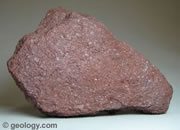
Iron Ore
A chemical sedimentary rock that forms when iron and oxygen (and sometimes other substances) combine in solution and deposit as a sediment. Hematite is the most common sedimentary iron ore mineral.
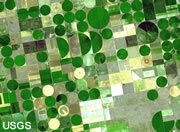
Irrigation Circles
A circular area that might be between a quarter mile and a mile in diameter that is planted with crops and supplied with water from a well in the center of the circle. The water from the well is distributed across the circle by a long beam the radius of the circle long that is covered with sprinkler heads and supported with wheels and one or more motors that drive the beam around the circle distributing water over the crops. Also called "center pivot irrigation" or "crop circles." The photo is a satellite image of center pivot irrigation sites in Finney County, Kansas.
Isograd
A line on a map that represents a specific degree of metamorphism. Rocks on one side of the line have been subjected to a greater level of metamorphism and on the other side of the line a lower level of metamorphism.
Isostasy
A condition of gravitational balance (similar to floating) in which a mass of lighter crustal rocks are buoyantly supported from below by denser mantle rocks. The crustal rocks above subside into the mantle until they have displaced an adequate amount of mantle material to support them.
Isotope
One of several forms of an element. These different forms have the same number of protons but varying numbers of neutrons.
|
| More General Geology |
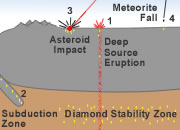 |
Diamonds from Coal? |
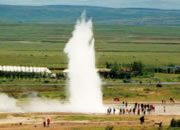 |
What is a Geyser? |
 |
What is the San Andreas Fault? |
 |
Igneous and Volcanic Features |
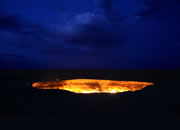 |
The Doorway to Hell |
 |
Topo Maps |
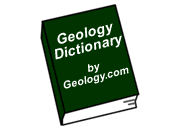 |
Geology Dictionary |
 |
Gifts That Rock |

Find Other Topics on Geology.com:

|

| ||

|

| ||

|

| ||

|

|

